Environment Impact of High-Rise Construction: UK Materials & Tech
VerifiedAdded on 2023/06/15
|79
|22214
|337
Report
AI Summary
This report investigates the environmental impact of high-rise construction in the UK, emphasizing the use of appropriate materials and construction technologies. It adopts a systematic literature review to identify key themes, including the impact on microclimatic conditions, the benefits of accommodating larger populations, the role of BIM, social requirements, modular construction, and the comparison between timber and concrete. The research aims to demonstrate the effects of residential building construction on the natural environment, evaluating factors influencing sustainable design and recommending suitable materials and technologies. It highlights the increasing trend of high-rise construction due to urbanization and population growth, while addressing concerns about sustainability and the need for special engineering systems. The findings are intended to guide construction industry practitioners in enhancing ecological conditions through informed material and technology choices. Desklib provides access to this report along with a wide array of study resources.
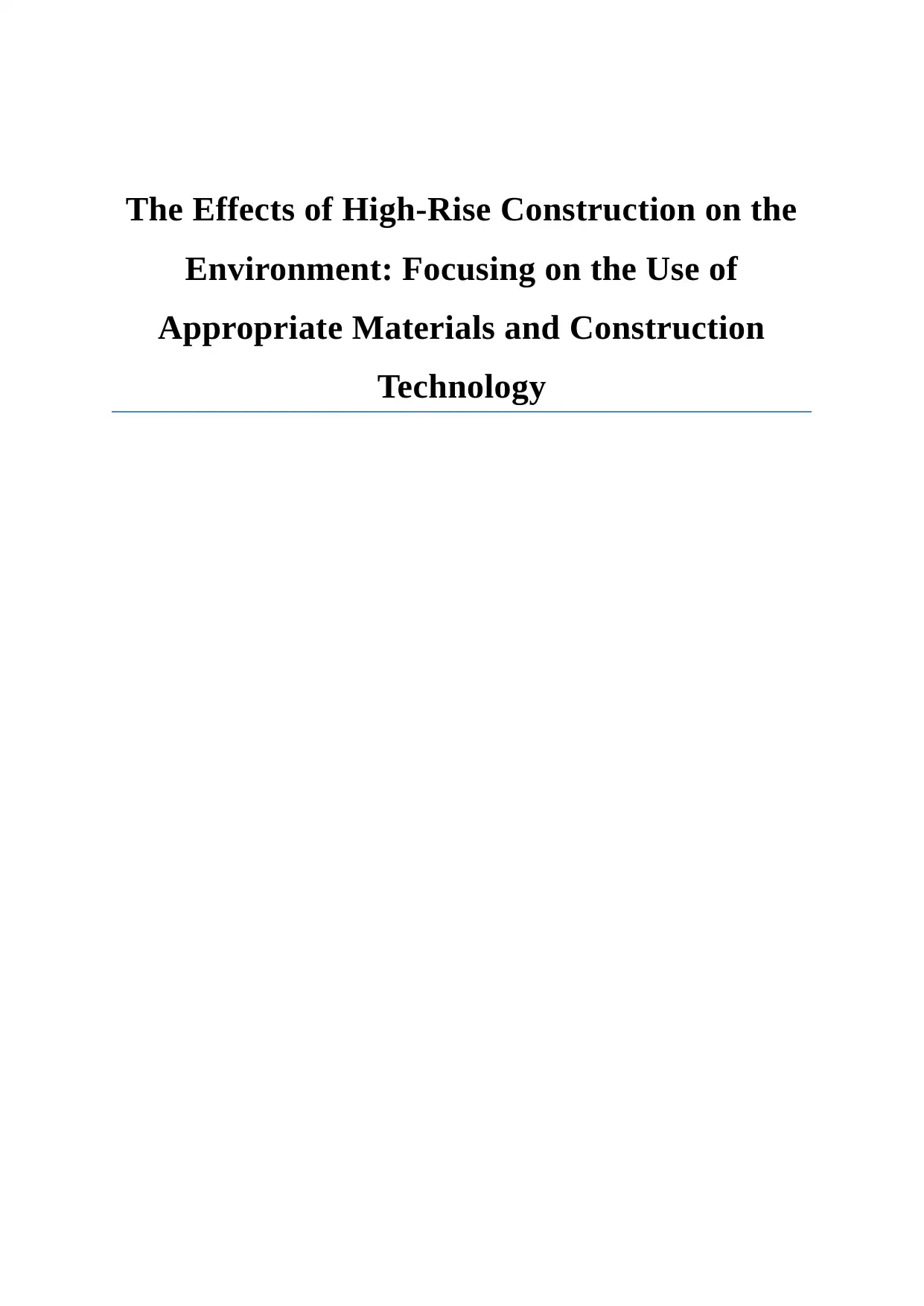
The Effects of High-Rise Construction on the
Environment: Focusing on the Use of
Appropriate Materials and Construction
Technology
Environment: Focusing on the Use of
Appropriate Materials and Construction
Technology
Paraphrase This Document
Need a fresh take? Get an instant paraphrase of this document with our AI Paraphraser

Acknowledgement
I would like to thank my supervisor and module tutor, who guided me throughout this process
of conducting the research. I am also always thankful to my friends and family, who have
always been my support system.
I would like to thank my supervisor and module tutor, who guided me throughout this process
of conducting the research. I am also always thankful to my friends and family, who have
always been my support system.
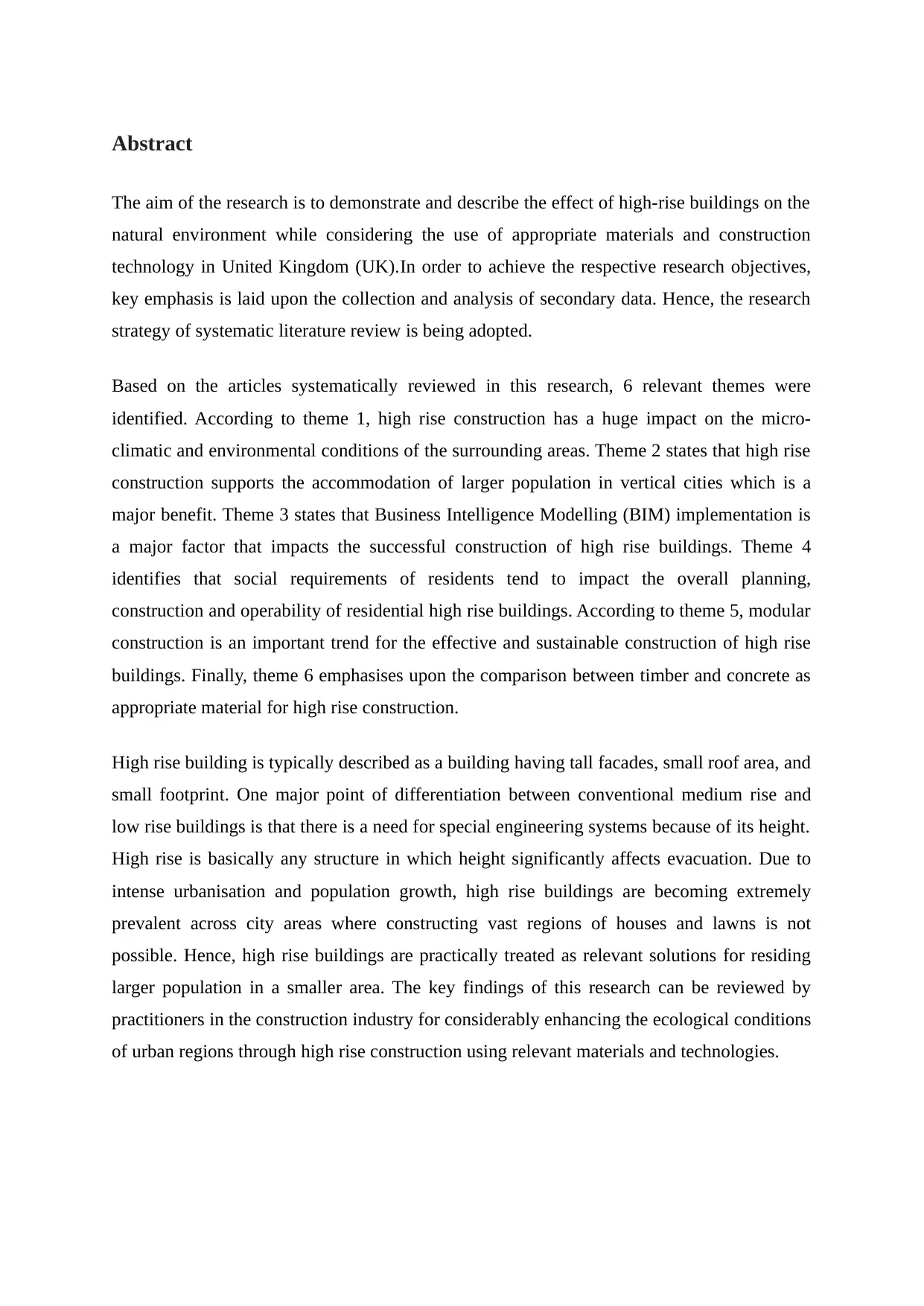
Abstract
The aim of the research is to demonstrate and describe the effect of high-rise buildings on the
natural environment while considering the use of appropriate materials and construction
technology in United Kingdom (UK).In order to achieve the respective research objectives,
key emphasis is laid upon the collection and analysis of secondary data. Hence, the research
strategy of systematic literature review is being adopted.
Based on the articles systematically reviewed in this research, 6 relevant themes were
identified. According to theme 1, high rise construction has a huge impact on the micro-
climatic and environmental conditions of the surrounding areas. Theme 2 states that high rise
construction supports the accommodation of larger population in vertical cities which is a
major benefit. Theme 3 states that Business Intelligence Modelling (BIM) implementation is
a major factor that impacts the successful construction of high rise buildings. Theme 4
identifies that social requirements of residents tend to impact the overall planning,
construction and operability of residential high rise buildings. According to theme 5, modular
construction is an important trend for the effective and sustainable construction of high rise
buildings. Finally, theme 6 emphasises upon the comparison between timber and concrete as
appropriate material for high rise construction.
High rise building is typically described as a building having tall facades, small roof area, and
small footprint. One major point of differentiation between conventional medium rise and
low rise buildings is that there is a need for special engineering systems because of its height.
High rise is basically any structure in which height significantly affects evacuation. Due to
intense urbanisation and population growth, high rise buildings are becoming extremely
prevalent across city areas where constructing vast regions of houses and lawns is not
possible. Hence, high rise buildings are practically treated as relevant solutions for residing
larger population in a smaller area. The key findings of this research can be reviewed by
practitioners in the construction industry for considerably enhancing the ecological conditions
of urban regions through high rise construction using relevant materials and technologies.
The aim of the research is to demonstrate and describe the effect of high-rise buildings on the
natural environment while considering the use of appropriate materials and construction
technology in United Kingdom (UK).In order to achieve the respective research objectives,
key emphasis is laid upon the collection and analysis of secondary data. Hence, the research
strategy of systematic literature review is being adopted.
Based on the articles systematically reviewed in this research, 6 relevant themes were
identified. According to theme 1, high rise construction has a huge impact on the micro-
climatic and environmental conditions of the surrounding areas. Theme 2 states that high rise
construction supports the accommodation of larger population in vertical cities which is a
major benefit. Theme 3 states that Business Intelligence Modelling (BIM) implementation is
a major factor that impacts the successful construction of high rise buildings. Theme 4
identifies that social requirements of residents tend to impact the overall planning,
construction and operability of residential high rise buildings. According to theme 5, modular
construction is an important trend for the effective and sustainable construction of high rise
buildings. Finally, theme 6 emphasises upon the comparison between timber and concrete as
appropriate material for high rise construction.
High rise building is typically described as a building having tall facades, small roof area, and
small footprint. One major point of differentiation between conventional medium rise and
low rise buildings is that there is a need for special engineering systems because of its height.
High rise is basically any structure in which height significantly affects evacuation. Due to
intense urbanisation and population growth, high rise buildings are becoming extremely
prevalent across city areas where constructing vast regions of houses and lawns is not
possible. Hence, high rise buildings are practically treated as relevant solutions for residing
larger population in a smaller area. The key findings of this research can be reviewed by
practitioners in the construction industry for considerably enhancing the ecological conditions
of urban regions through high rise construction using relevant materials and technologies.
⊘ This is a preview!⊘
Do you want full access?
Subscribe today to unlock all pages.

Trusted by 1+ million students worldwide
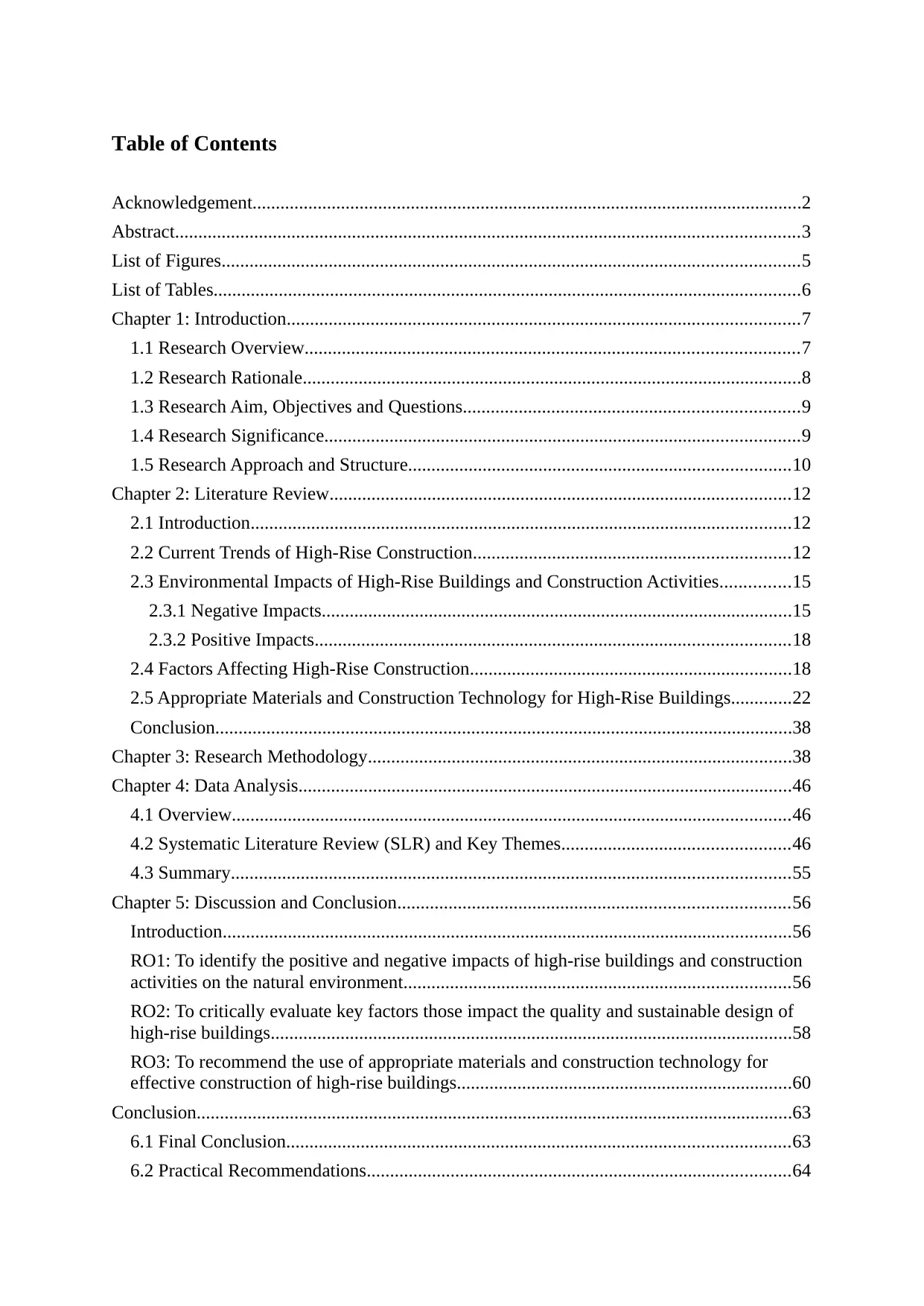
Table of Contents
Acknowledgement......................................................................................................................2
Abstract......................................................................................................................................3
List of Figures............................................................................................................................5
List of Tables..............................................................................................................................6
Chapter 1: Introduction..............................................................................................................7
1.1 Research Overview..........................................................................................................7
1.2 Research Rationale...........................................................................................................8
1.3 Research Aim, Objectives and Questions........................................................................9
1.4 Research Significance......................................................................................................9
1.5 Research Approach and Structure..................................................................................10
Chapter 2: Literature Review...................................................................................................12
2.1 Introduction....................................................................................................................12
2.2 Current Trends of High-Rise Construction....................................................................12
2.3 Environmental Impacts of High-Rise Buildings and Construction Activities...............15
2.3.1 Negative Impacts.....................................................................................................15
2.3.2 Positive Impacts......................................................................................................18
2.4 Factors Affecting High-Rise Construction.....................................................................18
2.5 Appropriate Materials and Construction Technology for High-Rise Buildings.............22
Conclusion............................................................................................................................38
Chapter 3: Research Methodology...........................................................................................38
Chapter 4: Data Analysis..........................................................................................................46
4.1 Overview........................................................................................................................46
4.2 Systematic Literature Review (SLR) and Key Themes.................................................46
4.3 Summary........................................................................................................................55
Chapter 5: Discussion and Conclusion....................................................................................56
Introduction..........................................................................................................................56
RO1: To identify the positive and negative impacts of high-rise buildings and construction
activities on the natural environment...................................................................................56
RO2: To critically evaluate key factors those impact the quality and sustainable design of
high-rise buildings................................................................................................................58
RO3: To recommend the use of appropriate materials and construction technology for
effective construction of high-rise buildings........................................................................60
Conclusion................................................................................................................................63
6.1 Final Conclusion............................................................................................................63
6.2 Practical Recommendations...........................................................................................64
Acknowledgement......................................................................................................................2
Abstract......................................................................................................................................3
List of Figures............................................................................................................................5
List of Tables..............................................................................................................................6
Chapter 1: Introduction..............................................................................................................7
1.1 Research Overview..........................................................................................................7
1.2 Research Rationale...........................................................................................................8
1.3 Research Aim, Objectives and Questions........................................................................9
1.4 Research Significance......................................................................................................9
1.5 Research Approach and Structure..................................................................................10
Chapter 2: Literature Review...................................................................................................12
2.1 Introduction....................................................................................................................12
2.2 Current Trends of High-Rise Construction....................................................................12
2.3 Environmental Impacts of High-Rise Buildings and Construction Activities...............15
2.3.1 Negative Impacts.....................................................................................................15
2.3.2 Positive Impacts......................................................................................................18
2.4 Factors Affecting High-Rise Construction.....................................................................18
2.5 Appropriate Materials and Construction Technology for High-Rise Buildings.............22
Conclusion............................................................................................................................38
Chapter 3: Research Methodology...........................................................................................38
Chapter 4: Data Analysis..........................................................................................................46
4.1 Overview........................................................................................................................46
4.2 Systematic Literature Review (SLR) and Key Themes.................................................46
4.3 Summary........................................................................................................................55
Chapter 5: Discussion and Conclusion....................................................................................56
Introduction..........................................................................................................................56
RO1: To identify the positive and negative impacts of high-rise buildings and construction
activities on the natural environment...................................................................................56
RO2: To critically evaluate key factors those impact the quality and sustainable design of
high-rise buildings................................................................................................................58
RO3: To recommend the use of appropriate materials and construction technology for
effective construction of high-rise buildings........................................................................60
Conclusion................................................................................................................................63
6.1 Final Conclusion............................................................................................................63
6.2 Practical Recommendations...........................................................................................64
Paraphrase This Document
Need a fresh take? Get an instant paraphrase of this document with our AI Paraphraser
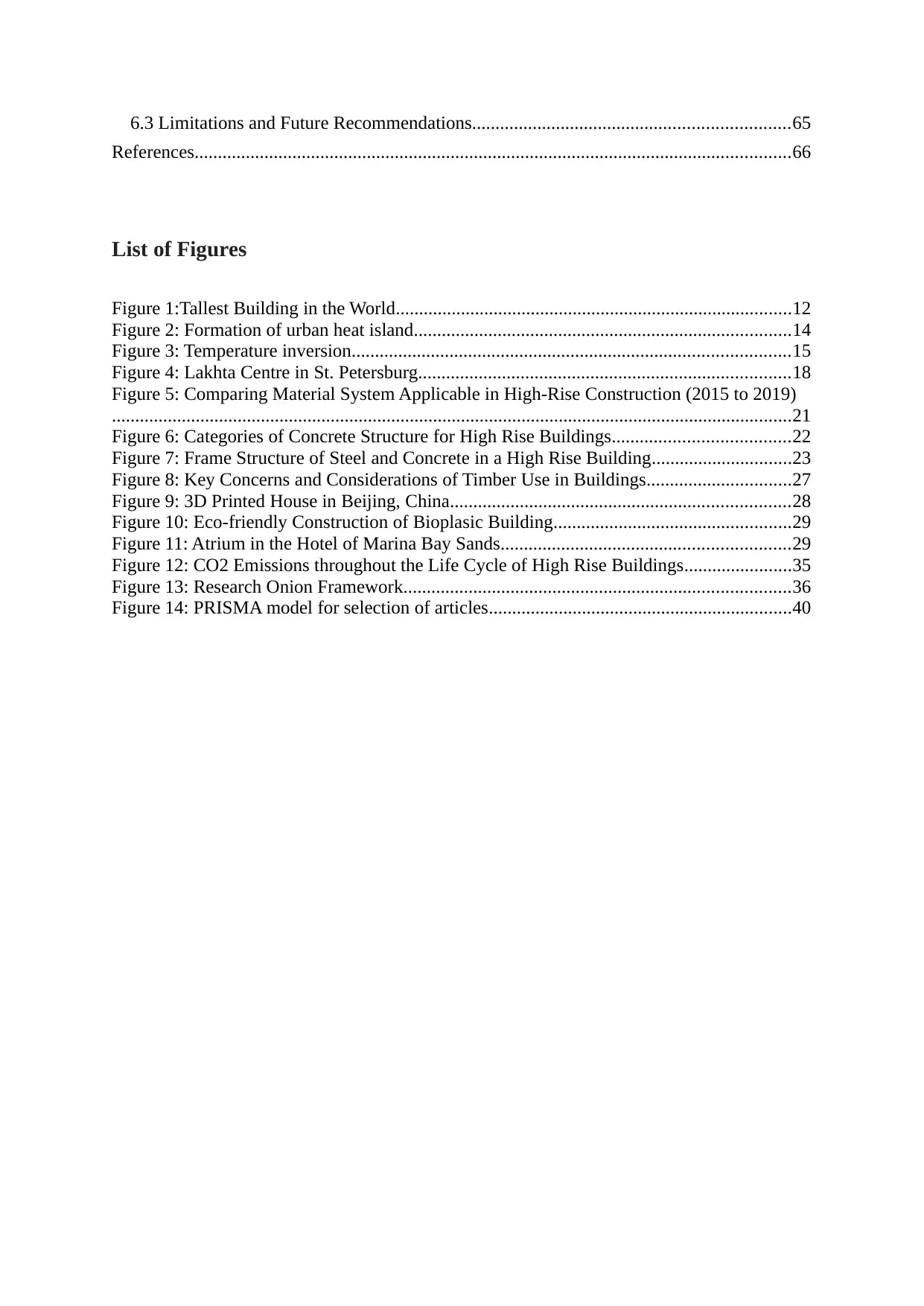
6.3 Limitations and Future Recommendations....................................................................65
References................................................................................................................................66
List of Figures
Figure 1:Tallest Building in the World.....................................................................................12
Figure 2: Formation of urban heat island.................................................................................14
Figure 3: Temperature inversion..............................................................................................15
Figure 4: Lakhta Centre in St. Petersburg................................................................................18
Figure 5: Comparing Material System Applicable in High-Rise Construction (2015 to 2019)
..................................................................................................................................................21
Figure 6: Categories of Concrete Structure for High Rise Buildings......................................22
Figure 7: Frame Structure of Steel and Concrete in a High Rise Building..............................23
Figure 8: Key Concerns and Considerations of Timber Use in Buildings...............................27
Figure 9: 3D Printed House in Beijing, China.........................................................................28
Figure 10: Eco-friendly Construction of Bioplasic Building...................................................29
Figure 11: Atrium in the Hotel of Marina Bay Sands..............................................................29
Figure 12: CO2 Emissions throughout the Life Cycle of High Rise Buildings.......................35
Figure 13: Research Onion Framework...................................................................................36
Figure 14: PRISMA model for selection of articles.................................................................40
References................................................................................................................................66
List of Figures
Figure 1:Tallest Building in the World.....................................................................................12
Figure 2: Formation of urban heat island.................................................................................14
Figure 3: Temperature inversion..............................................................................................15
Figure 4: Lakhta Centre in St. Petersburg................................................................................18
Figure 5: Comparing Material System Applicable in High-Rise Construction (2015 to 2019)
..................................................................................................................................................21
Figure 6: Categories of Concrete Structure for High Rise Buildings......................................22
Figure 7: Frame Structure of Steel and Concrete in a High Rise Building..............................23
Figure 8: Key Concerns and Considerations of Timber Use in Buildings...............................27
Figure 9: 3D Printed House in Beijing, China.........................................................................28
Figure 10: Eco-friendly Construction of Bioplasic Building...................................................29
Figure 11: Atrium in the Hotel of Marina Bay Sands..............................................................29
Figure 12: CO2 Emissions throughout the Life Cycle of High Rise Buildings.......................35
Figure 13: Research Onion Framework...................................................................................36
Figure 14: PRISMA model for selection of articles.................................................................40

List of Tables
Table 1: Indicative Attributes of Different Glass Categories...................................................25
Table 2: Inclusion and Exclusion Criteria for SLR..................................................................41
Table 1: Indicative Attributes of Different Glass Categories...................................................25
Table 2: Inclusion and Exclusion Criteria for SLR..................................................................41
⊘ This is a preview!⊘
Do you want full access?
Subscribe today to unlock all pages.

Trusted by 1+ million students worldwide
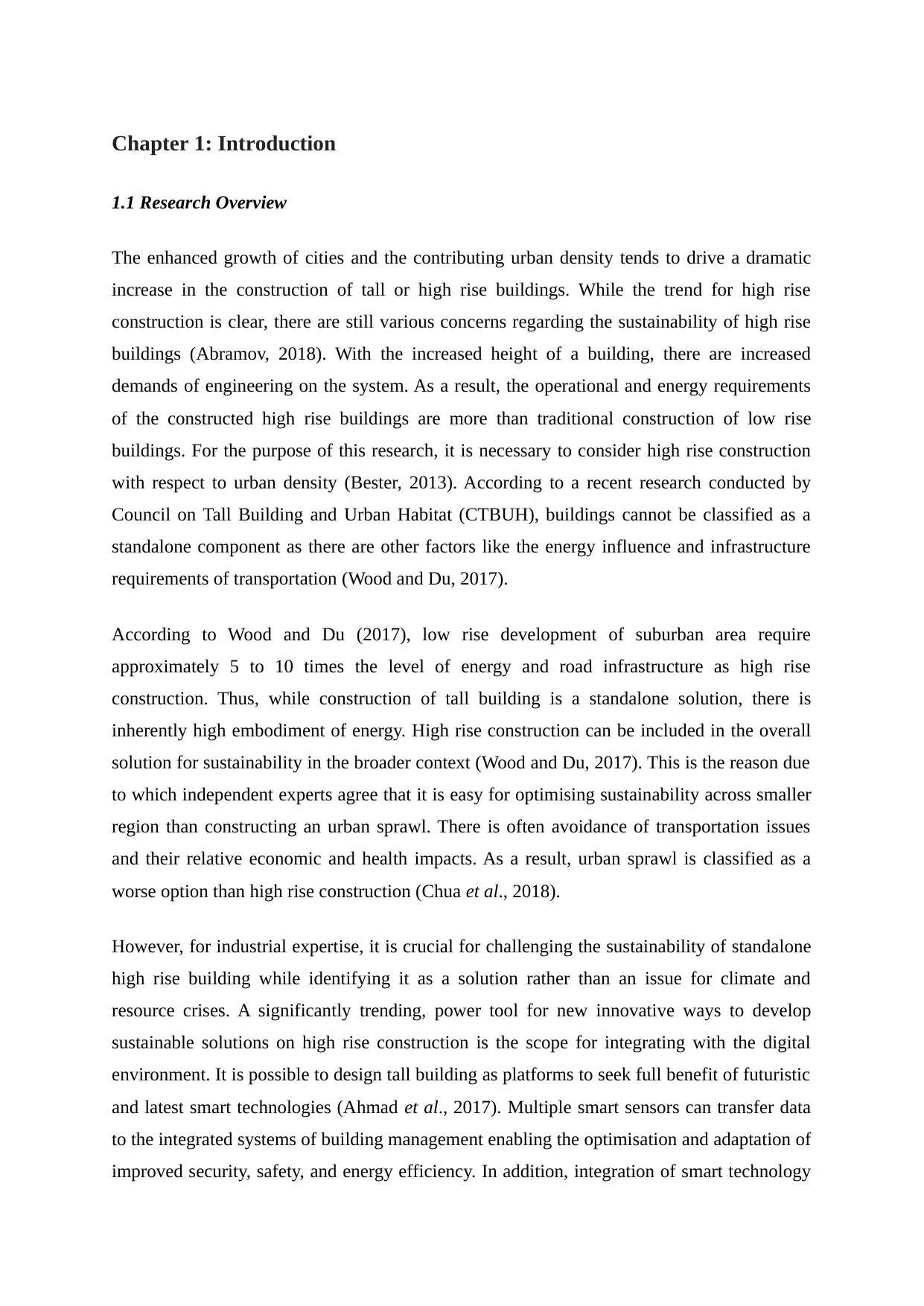
Chapter 1: Introduction
1.1 Research Overview
The enhanced growth of cities and the contributing urban density tends to drive a dramatic
increase in the construction of tall or high rise buildings. While the trend for high rise
construction is clear, there are still various concerns regarding the sustainability of high rise
buildings (Abramov, 2018). With the increased height of a building, there are increased
demands of engineering on the system. As a result, the operational and energy requirements
of the constructed high rise buildings are more than traditional construction of low rise
buildings. For the purpose of this research, it is necessary to consider high rise construction
with respect to urban density (Bester, 2013). According to a recent research conducted by
Council on Tall Building and Urban Habitat (CTBUH), buildings cannot be classified as a
standalone component as there are other factors like the energy influence and infrastructure
requirements of transportation (Wood and Du, 2017).
According to Wood and Du (2017), low rise development of suburban area require
approximately 5 to 10 times the level of energy and road infrastructure as high rise
construction. Thus, while construction of tall building is a standalone solution, there is
inherently high embodiment of energy. High rise construction can be included in the overall
solution for sustainability in the broader context (Wood and Du, 2017). This is the reason due
to which independent experts agree that it is easy for optimising sustainability across smaller
region than constructing an urban sprawl. There is often avoidance of transportation issues
and their relative economic and health impacts. As a result, urban sprawl is classified as a
worse option than high rise construction (Chua et al., 2018).
However, for industrial expertise, it is crucial for challenging the sustainability of standalone
high rise building while identifying it as a solution rather than an issue for climate and
resource crises. A significantly trending, power tool for new innovative ways to develop
sustainable solutions on high rise construction is the scope for integrating with the digital
environment. It is possible to design tall building as platforms to seek full benefit of futuristic
and latest smart technologies (Ahmad et al., 2017). Multiple smart sensors can transfer data
to the integrated systems of building management enabling the optimisation and adaptation of
improved security, safety, and energy efficiency. In addition, integration of smart technology
1.1 Research Overview
The enhanced growth of cities and the contributing urban density tends to drive a dramatic
increase in the construction of tall or high rise buildings. While the trend for high rise
construction is clear, there are still various concerns regarding the sustainability of high rise
buildings (Abramov, 2018). With the increased height of a building, there are increased
demands of engineering on the system. As a result, the operational and energy requirements
of the constructed high rise buildings are more than traditional construction of low rise
buildings. For the purpose of this research, it is necessary to consider high rise construction
with respect to urban density (Bester, 2013). According to a recent research conducted by
Council on Tall Building and Urban Habitat (CTBUH), buildings cannot be classified as a
standalone component as there are other factors like the energy influence and infrastructure
requirements of transportation (Wood and Du, 2017).
According to Wood and Du (2017), low rise development of suburban area require
approximately 5 to 10 times the level of energy and road infrastructure as high rise
construction. Thus, while construction of tall building is a standalone solution, there is
inherently high embodiment of energy. High rise construction can be included in the overall
solution for sustainability in the broader context (Wood and Du, 2017). This is the reason due
to which independent experts agree that it is easy for optimising sustainability across smaller
region than constructing an urban sprawl. There is often avoidance of transportation issues
and their relative economic and health impacts. As a result, urban sprawl is classified as a
worse option than high rise construction (Chua et al., 2018).
However, for industrial expertise, it is crucial for challenging the sustainability of standalone
high rise building while identifying it as a solution rather than an issue for climate and
resource crises. A significantly trending, power tool for new innovative ways to develop
sustainable solutions on high rise construction is the scope for integrating with the digital
environment. It is possible to design tall building as platforms to seek full benefit of futuristic
and latest smart technologies (Ahmad et al., 2017). Multiple smart sensors can transfer data
to the integrated systems of building management enabling the optimisation and adaptation of
improved security, safety, and energy efficiency. In addition, integration of smart technology
Paraphrase This Document
Need a fresh take? Get an instant paraphrase of this document with our AI Paraphraser
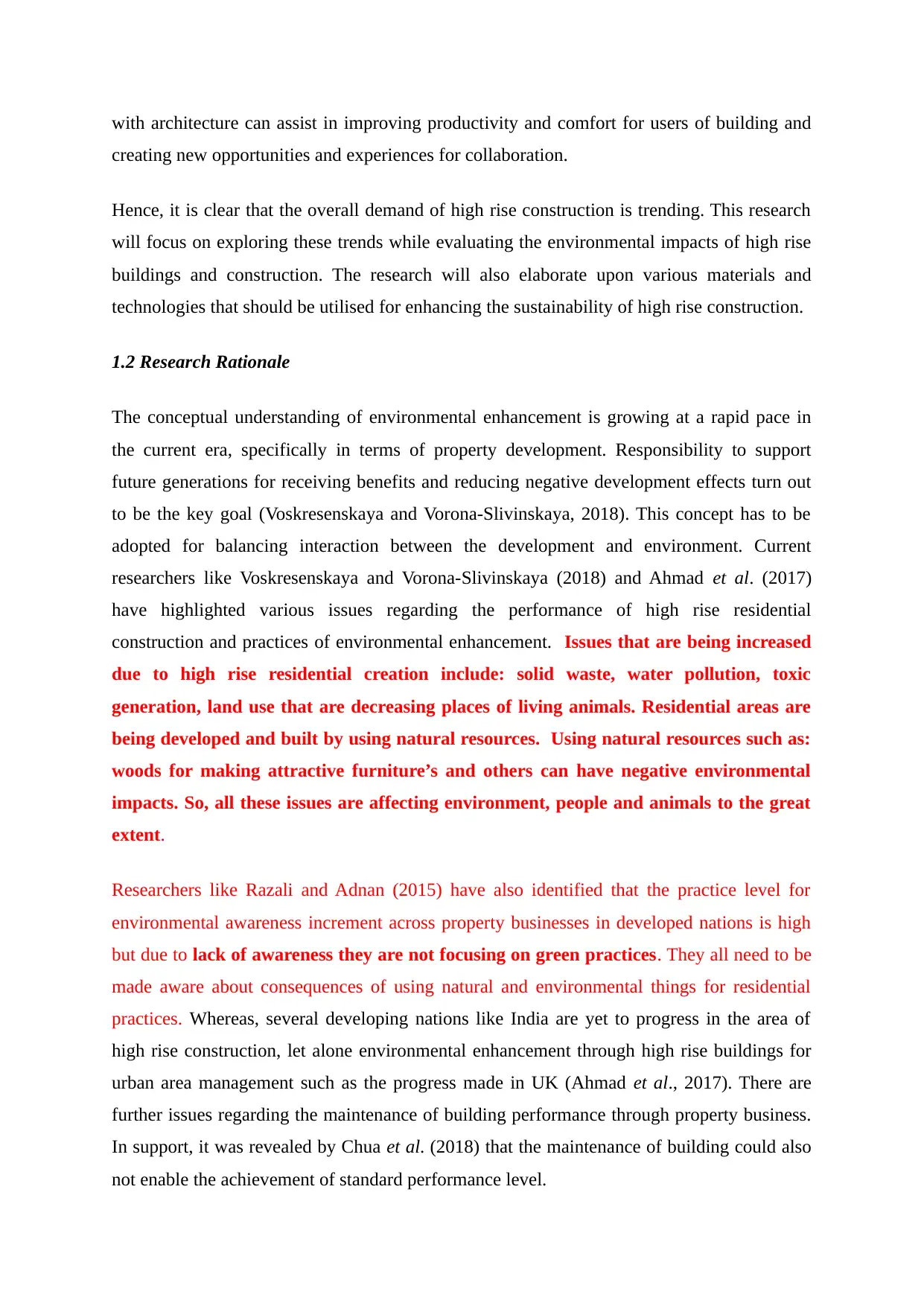
with architecture can assist in improving productivity and comfort for users of building and
creating new opportunities and experiences for collaboration.
Hence, it is clear that the overall demand of high rise construction is trending. This research
will focus on exploring these trends while evaluating the environmental impacts of high rise
buildings and construction. The research will also elaborate upon various materials and
technologies that should be utilised for enhancing the sustainability of high rise construction.
1.2 Research Rationale
The conceptual understanding of environmental enhancement is growing at a rapid pace in
the current era, specifically in terms of property development. Responsibility to support
future generations for receiving benefits and reducing negative development effects turn out
to be the key goal (Voskresenskaya and Vorona-Slivinskaya, 2018). This concept has to be
adopted for balancing interaction between the development and environment. Current
researchers like Voskresenskaya and Vorona-Slivinskaya (2018) and Ahmad et al. (2017)
have highlighted various issues regarding the performance of high rise residential
construction and practices of environmental enhancement. Issues that are being increased
due to high rise residential creation include: solid waste, water pollution, toxic
generation, land use that are decreasing places of living animals. Residential areas are
being developed and built by using natural resources. Using natural resources such as:
woods for making attractive furniture’s and others can have negative environmental
impacts. So, all these issues are affecting environment, people and animals to the great
extent.
Researchers like Razali and Adnan (2015) have also identified that the practice level for
environmental awareness increment across property businesses in developed nations is high
but due to lack of awareness they are not focusing on green practices. They all need to be
made aware about consequences of using natural and environmental things for residential
practices. Whereas, several developing nations like India are yet to progress in the area of
high rise construction, let alone environmental enhancement through high rise buildings for
urban area management such as the progress made in UK (Ahmad et al., 2017). There are
further issues regarding the maintenance of building performance through property business.
In support, it was revealed by Chua et al. (2018) that the maintenance of building could also
not enable the achievement of standard performance level.
creating new opportunities and experiences for collaboration.
Hence, it is clear that the overall demand of high rise construction is trending. This research
will focus on exploring these trends while evaluating the environmental impacts of high rise
buildings and construction. The research will also elaborate upon various materials and
technologies that should be utilised for enhancing the sustainability of high rise construction.
1.2 Research Rationale
The conceptual understanding of environmental enhancement is growing at a rapid pace in
the current era, specifically in terms of property development. Responsibility to support
future generations for receiving benefits and reducing negative development effects turn out
to be the key goal (Voskresenskaya and Vorona-Slivinskaya, 2018). This concept has to be
adopted for balancing interaction between the development and environment. Current
researchers like Voskresenskaya and Vorona-Slivinskaya (2018) and Ahmad et al. (2017)
have highlighted various issues regarding the performance of high rise residential
construction and practices of environmental enhancement. Issues that are being increased
due to high rise residential creation include: solid waste, water pollution, toxic
generation, land use that are decreasing places of living animals. Residential areas are
being developed and built by using natural resources. Using natural resources such as:
woods for making attractive furniture’s and others can have negative environmental
impacts. So, all these issues are affecting environment, people and animals to the great
extent.
Researchers like Razali and Adnan (2015) have also identified that the practice level for
environmental awareness increment across property businesses in developed nations is high
but due to lack of awareness they are not focusing on green practices. They all need to be
made aware about consequences of using natural and environmental things for residential
practices. Whereas, several developing nations like India are yet to progress in the area of
high rise construction, let alone environmental enhancement through high rise buildings for
urban area management such as the progress made in UK (Ahmad et al., 2017). There are
further issues regarding the maintenance of building performance through property business.
In support, it was revealed by Chua et al. (2018) that the maintenance of building could also
not enable the achievement of standard performance level.
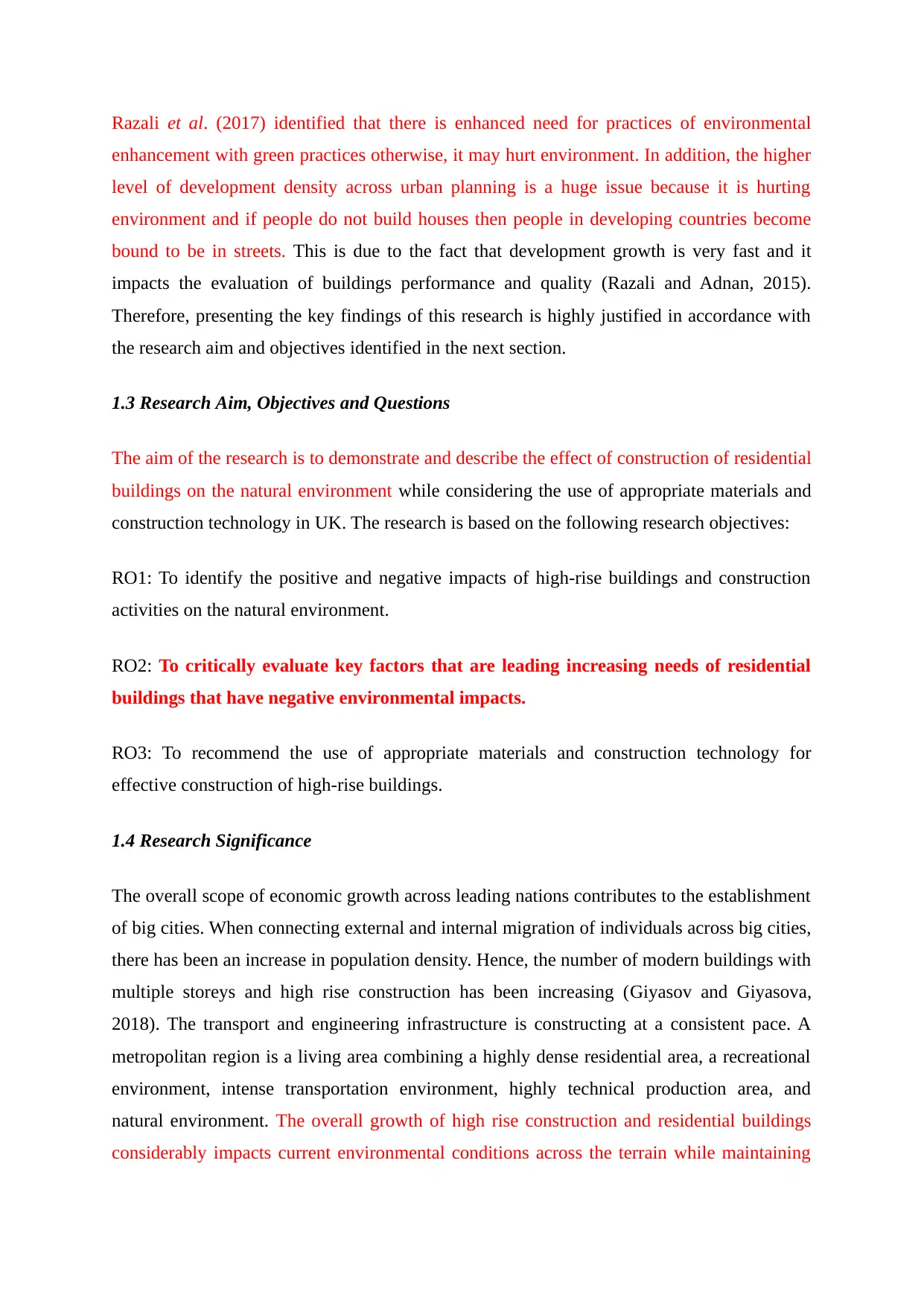
Razali et al. (2017) identified that there is enhanced need for practices of environmental
enhancement with green practices otherwise, it may hurt environment. In addition, the higher
level of development density across urban planning is a huge issue because it is hurting
environment and if people do not build houses then people in developing countries become
bound to be in streets. This is due to the fact that development growth is very fast and it
impacts the evaluation of buildings performance and quality (Razali and Adnan, 2015).
Therefore, presenting the key findings of this research is highly justified in accordance with
the research aim and objectives identified in the next section.
1.3 Research Aim, Objectives and Questions
The aim of the research is to demonstrate and describe the effect of construction of residential
buildings on the natural environment while considering the use of appropriate materials and
construction technology in UK. The research is based on the following research objectives:
RO1: To identify the positive and negative impacts of high-rise buildings and construction
activities on the natural environment.
RO2: To critically evaluate key factors that are leading increasing needs of residential
buildings that have negative environmental impacts.
RO3: To recommend the use of appropriate materials and construction technology for
effective construction of high-rise buildings.
1.4 Research Significance
The overall scope of economic growth across leading nations contributes to the establishment
of big cities. When connecting external and internal migration of individuals across big cities,
there has been an increase in population density. Hence, the number of modern buildings with
multiple storeys and high rise construction has been increasing (Giyasov and Giyasova,
2018). The transport and engineering infrastructure is constructing at a consistent pace. A
metropolitan region is a living area combining a highly dense residential area, a recreational
environment, intense transportation environment, highly technical production area, and
natural environment. The overall growth of high rise construction and residential buildings
considerably impacts current environmental conditions across the terrain while maintaining
enhancement with green practices otherwise, it may hurt environment. In addition, the higher
level of development density across urban planning is a huge issue because it is hurting
environment and if people do not build houses then people in developing countries become
bound to be in streets. This is due to the fact that development growth is very fast and it
impacts the evaluation of buildings performance and quality (Razali and Adnan, 2015).
Therefore, presenting the key findings of this research is highly justified in accordance with
the research aim and objectives identified in the next section.
1.3 Research Aim, Objectives and Questions
The aim of the research is to demonstrate and describe the effect of construction of residential
buildings on the natural environment while considering the use of appropriate materials and
construction technology in UK. The research is based on the following research objectives:
RO1: To identify the positive and negative impacts of high-rise buildings and construction
activities on the natural environment.
RO2: To critically evaluate key factors that are leading increasing needs of residential
buildings that have negative environmental impacts.
RO3: To recommend the use of appropriate materials and construction technology for
effective construction of high-rise buildings.
1.4 Research Significance
The overall scope of economic growth across leading nations contributes to the establishment
of big cities. When connecting external and internal migration of individuals across big cities,
there has been an increase in population density. Hence, the number of modern buildings with
multiple storeys and high rise construction has been increasing (Giyasov and Giyasova,
2018). The transport and engineering infrastructure is constructing at a consistent pace. A
metropolitan region is a living area combining a highly dense residential area, a recreational
environment, intense transportation environment, highly technical production area, and
natural environment. The overall growth of high rise construction and residential buildings
considerably impacts current environmental conditions across the terrain while maintaining
⊘ This is a preview!⊘
Do you want full access?
Subscribe today to unlock all pages.

Trusted by 1+ million students worldwide

ecological balance across the living area as it increases solid waste, noise, air pollution,
hazardous emission and alteration in breeding patterns (Romanova, 2018).
High rise building is typically described as a building having tall facades, small roof area, and
small footprint. One major point of differentiation between conventional medium rise and
low rise buildings is that there is a need for special engineering systems because of its height.
High rise is basically any structure in which height significantly affects evacuation. Due to
intense urbanisation and population growth, high rise buildings are becoming extremely
prevalent across city areas where constructing vast regions of houses and lawns is not
possible. As needs of people are increasing as everyone wants to be in well-developed or
constructed houses but they are not realising as it is affecting natural environment. The key
findings of this research can be reviewed by practitioners in the construction industry for
considerably enhancing the ecological conditions of urban regions through high rise
construction using relevant materials and technologies.
1.5 Research Approach and Structure
In order to achieve the respective research objectives, key emphasis will be laid upon the
collection and analysis of secondary data. Hence, the research strategy of systematic literature
review will be adopted as on the basis of secondary or existing data, it becomes easier in
identifying impacts of residential buildings on natural environment. 10 to 15 research articles
will be selected on the basis of the following key words: High-rise buildings, high-rise
construction, construction technology, material, environmental impact, and sustainability.
Only those articles will be selected that have been published between 2010 and 2020, and
with full text availability. The reason of selecting data of these years is to get reliable and
accurate information and making research study with effectiveness. The publish years from
2010 to 2020 was decided to diversify the choice of research articles. There were some
articles that were relevant to the research but published between 2012 and 2015. The publish
year range of 2010 and 2020 also provided a significant scope to compare past trends with the
future trends of high rise construction. It can help researchers in making research study
accurate and reliable.
hazardous emission and alteration in breeding patterns (Romanova, 2018).
High rise building is typically described as a building having tall facades, small roof area, and
small footprint. One major point of differentiation between conventional medium rise and
low rise buildings is that there is a need for special engineering systems because of its height.
High rise is basically any structure in which height significantly affects evacuation. Due to
intense urbanisation and population growth, high rise buildings are becoming extremely
prevalent across city areas where constructing vast regions of houses and lawns is not
possible. As needs of people are increasing as everyone wants to be in well-developed or
constructed houses but they are not realising as it is affecting natural environment. The key
findings of this research can be reviewed by practitioners in the construction industry for
considerably enhancing the ecological conditions of urban regions through high rise
construction using relevant materials and technologies.
1.5 Research Approach and Structure
In order to achieve the respective research objectives, key emphasis will be laid upon the
collection and analysis of secondary data. Hence, the research strategy of systematic literature
review will be adopted as on the basis of secondary or existing data, it becomes easier in
identifying impacts of residential buildings on natural environment. 10 to 15 research articles
will be selected on the basis of the following key words: High-rise buildings, high-rise
construction, construction technology, material, environmental impact, and sustainability.
Only those articles will be selected that have been published between 2010 and 2020, and
with full text availability. The reason of selecting data of these years is to get reliable and
accurate information and making research study with effectiveness. The publish years from
2010 to 2020 was decided to diversify the choice of research articles. There were some
articles that were relevant to the research but published between 2012 and 2015. The publish
year range of 2010 and 2020 also provided a significant scope to compare past trends with the
future trends of high rise construction. It can help researchers in making research study
accurate and reliable.
Paraphrase This Document
Need a fresh take? Get an instant paraphrase of this document with our AI Paraphraser

Introduction The first chapter (Introduction) of this
research describes and justifies the research
topic while identifying the research aim and
objectives.
Literature Review The second chapter (Literature Review) will
review existing articles demonstrating
current trends of high-rise construction
while recommending appropriate materials
and construction technology. The chapter
will discuss about the positive and negative
implications of high rise building and
construction activities. Case study examples
from the construction industry will be also
be discussed and reviewed.
Research Methodology The third chapter (Research Methodology)
will describe and justify every choice
related to the Research Onion framework
for collecting and analysing data in this
research.
Key findings The fourth chapter (Key Findings) will
provide a tabular presentation of the
secondary data collected from the
Systematic Literature Review strategy.
research describes and justifies the research
topic while identifying the research aim and
objectives.
Literature Review The second chapter (Literature Review) will
review existing articles demonstrating
current trends of high-rise construction
while recommending appropriate materials
and construction technology. The chapter
will discuss about the positive and negative
implications of high rise building and
construction activities. Case study examples
from the construction industry will be also
be discussed and reviewed.
Research Methodology The third chapter (Research Methodology)
will describe and justify every choice
related to the Research Onion framework
for collecting and analysing data in this
research.
Key findings The fourth chapter (Key Findings) will
provide a tabular presentation of the
secondary data collected from the
Systematic Literature Review strategy.
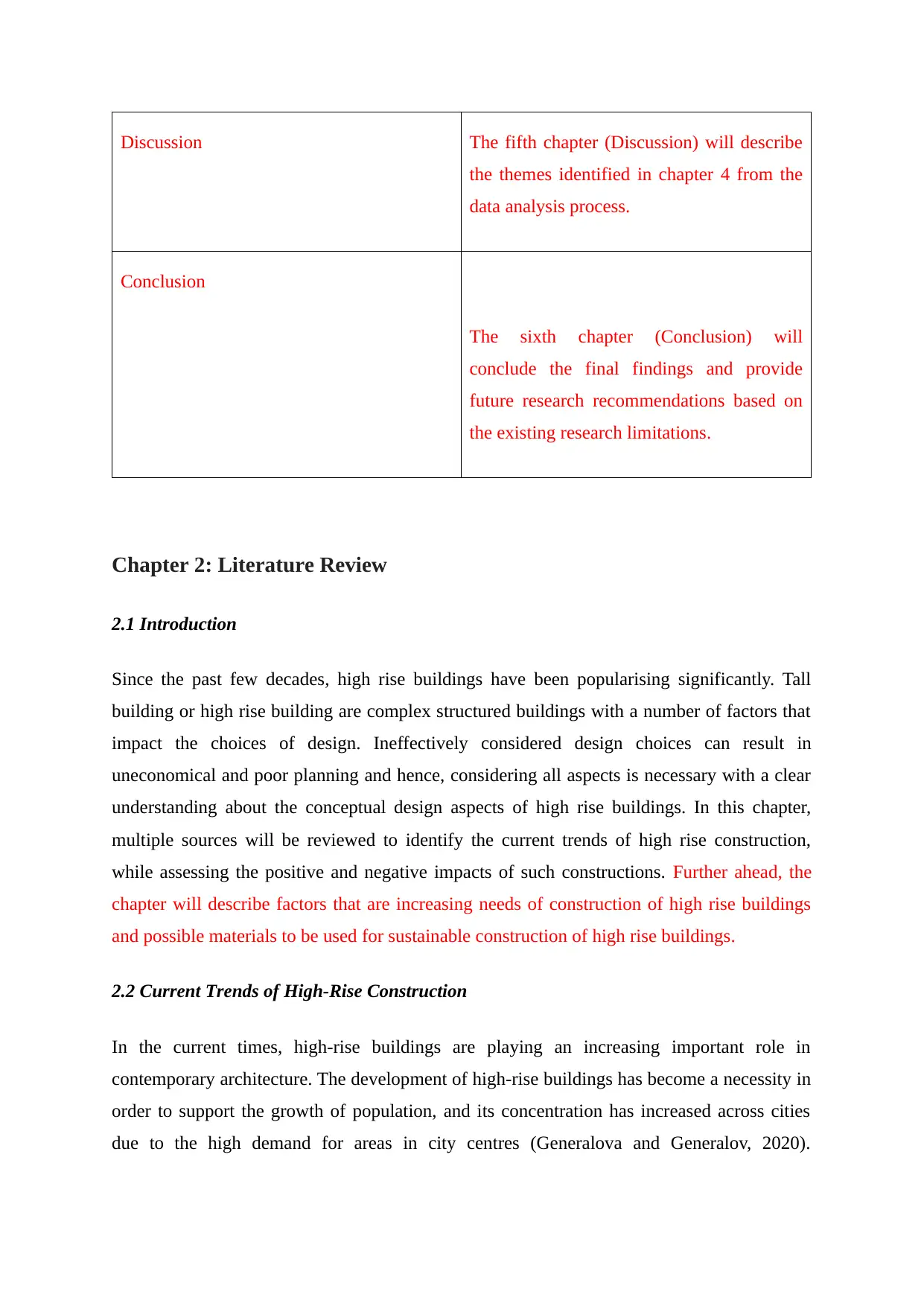
Discussion The fifth chapter (Discussion) will describe
the themes identified in chapter 4 from the
data analysis process.
Conclusion
The sixth chapter (Conclusion) will
conclude the final findings and provide
future research recommendations based on
the existing research limitations.
Chapter 2: Literature Review
2.1 Introduction
Since the past few decades, high rise buildings have been popularising significantly. Tall
building or high rise building are complex structured buildings with a number of factors that
impact the choices of design. Ineffectively considered design choices can result in
uneconomical and poor planning and hence, considering all aspects is necessary with a clear
understanding about the conceptual design aspects of high rise buildings. In this chapter,
multiple sources will be reviewed to identify the current trends of high rise construction,
while assessing the positive and negative impacts of such constructions. Further ahead, the
chapter will describe factors that are increasing needs of construction of high rise buildings
and possible materials to be used for sustainable construction of high rise buildings.
2.2 Current Trends of High-Rise Construction
In the current times, high-rise buildings are playing an increasing important role in
contemporary architecture. The development of high-rise buildings has become a necessity in
order to support the growth of population, and its concentration has increased across cities
due to the high demand for areas in city centres (Generalova and Generalov, 2020).
the themes identified in chapter 4 from the
data analysis process.
Conclusion
The sixth chapter (Conclusion) will
conclude the final findings and provide
future research recommendations based on
the existing research limitations.
Chapter 2: Literature Review
2.1 Introduction
Since the past few decades, high rise buildings have been popularising significantly. Tall
building or high rise building are complex structured buildings with a number of factors that
impact the choices of design. Ineffectively considered design choices can result in
uneconomical and poor planning and hence, considering all aspects is necessary with a clear
understanding about the conceptual design aspects of high rise buildings. In this chapter,
multiple sources will be reviewed to identify the current trends of high rise construction,
while assessing the positive and negative impacts of such constructions. Further ahead, the
chapter will describe factors that are increasing needs of construction of high rise buildings
and possible materials to be used for sustainable construction of high rise buildings.
2.2 Current Trends of High-Rise Construction
In the current times, high-rise buildings are playing an increasing important role in
contemporary architecture. The development of high-rise buildings has become a necessity in
order to support the growth of population, and its concentration has increased across cities
due to the high demand for areas in city centres (Generalova and Generalov, 2020).
⊘ This is a preview!⊘
Do you want full access?
Subscribe today to unlock all pages.

Trusted by 1+ million students worldwide
1 out of 79
Related Documents
Your All-in-One AI-Powered Toolkit for Academic Success.
+13062052269
info@desklib.com
Available 24*7 on WhatsApp / Email
![[object Object]](/_next/static/media/star-bottom.7253800d.svg)
Unlock your academic potential
Copyright © 2020–2025 A2Z Services. All Rights Reserved. Developed and managed by ZUCOL.





